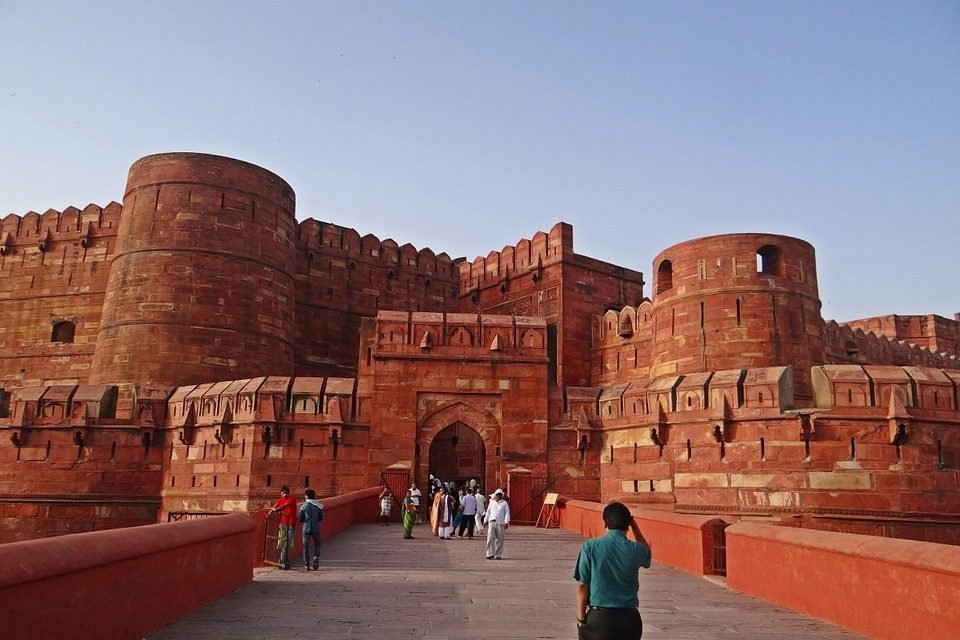Agra Fort: Exploring the Majestic Red Fort of Agra, India
When one thinks of Agra, the Taj Mahal often steals the spotlight — but just a few kilometers away stands an equally magnificent testament to Mughal grandeur: Agra Fort. This UNESCO World Heritage site is not only an architectural masterpiece but also a silent witness to India’s royal past, power struggles, and the splendor of the Mughal era.
Agra Fort : A Glimpse Into History
Agra Fort, also known as the Red Fort of Agra, is a 16th-century fortress built primarily with red sandstone. Commissioned by Emperor Akbar in 1565, it later saw significant additions by his grandson, Shah Jahan — the same emperor who built the Taj Mahal.

For centuries, this fort served as the main residence of the Mughal emperors and was the epicenter of administration, military strategy, and royal life. Some historians even refer to it as a walled city due to its sprawling layout and numerous palaces within its walls.
Architectural Marvel
Spanning about 94 acres, Agra Fort is encircled by massive double battlemented walls rising over 70 feet high. Four grand gates, of which the Delhi Gate and Amar Singh Gate are the most prominent, offer access to this fortified palace.
Inside, visitors are greeted by a fascinating blend of Islamic and Hindu architectural styles, featuring intricate marble inlays, ornate carvings, beautiful courtyards, and lush gardens. Some of the must-see structures inside the fort include:
- Jahangiri Mahal: One of the oldest surviving palaces, showcasing a mix of Hindu and Central Asian influences.
- Diwan-i-Am (Hall of Public Audience): Where the emperor addressed the general public and heard their grievances.
- Diwan-i-Khas (Hall of Private Audience): An elegant hall where the emperor met important dignitaries and foreign envoys.
- Moti Masjid (Pearl Mosque): A pristine white marble mosque built by Shah Jahan for the royal family’s private prayers.
- Musamman Burj: The beautiful octagonal tower where Shah Jahan was held captive by his son Aurangzeb, spending his last days gazing at the Taj Mahal in the distance.
Agra Fort vs. Red Fort in Delhi
It’s common for travelers to confuse Agra Fort with Delhi’s Red Fort. While both were vital Mughal strongholds, Agra Fort is older and served as the primary seat of the empire before Shah Jahan shifted the capital to Delhi.
Tips for Visiting Agra Fort
- Timings: Open daily from sunrise to sunset (approx. 6 AM to 6 PM).
- Entry Fee: There is a nominal fee for Indian and foreign tourists; tickets can be booked online or at the entrance.
- Best Time to Visit: October to March, when the weather is pleasant.
- Guides & Audio Tours: Hiring a licensed guide or using an audio guide enhances the experience and provides deep historical context.
- Dress Comfortably: Wear comfortable shoes as you’ll be walking a lot across expansive courtyards and corridors.
Getting There
Agra Fort is conveniently located just 2.5 km from the Taj Mahal and is easily accessible by car, auto-rickshaw, or local transport. If you’re on same day agra tour by car, visiting both the Taj Mahal and Agra Fort is highly recommended to get a fuller picture of the city’s rich heritage.
Final Thoughts
Agra Fort stands as an enduring symbol of India’s royal grandeur and turbulent history. With its grand gates, palaces, and tales of emperors and betrayals, it promises an immersive journey into the Mughal era for every visitor. So, next time you plan your Taj mahal tour package, make sure you reserve enough time to explore this majestic fort — a true jewel in India’s crown of heritage.